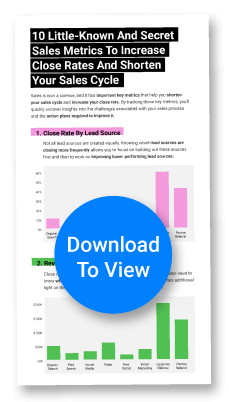
5 New Tools and Tactics Sales Teams Are Using To Smash Their Quotas
It used to be common for CEOs to simply hire more salespeople when they wanted to grow. Today, CEOs are smarter and know that you can do more revenue with the same number of reps if you arm the reps with the right tools and techniques to make them more efficient and help them close more deals.
But what are those tools? What are those techniques? It’s still a little more confusing than necessary when it comes to sales effort upgrades.
With the fourth quarter in full swing, now is the time to look objectively at your sales execution and start putting new tools in place so that 2024 is your best year ever.
Here are five considerations for your sales execution upgrade efforts.
1. Lead Scoring
Lead scoring is a popular methodology that marketing and sales teams use to determine how likely their prospects are to buy. It’s a process where you assign a score (often 1-100) to your leads to gauge their probabilistic buying intention. The higher the score, the more likely they’ll buy.
More importantly, the lead score helps sales reps spend time with the people who are most likely to close and close quickly while behind the scenes nurturing the lower-scored leads until their score warrants a rep’s personal attention.
A few types of data usually go into the score calculation:
Demographic Info – This is usually the easiest to capture and the easiest to use. Is this person in the right role to make a decision? Is this company in the target industry? Is this company the right size – either employees, revenue or, in some cases, specific numbers like sales reps, service reps, etc.? Is this company in the right region or location?
All these data points can be part of your lead score. The more they align with your best customer or prospect, the higher the score.
Behavioral Info – How a person interacts with your website, email or content is equally important in helping you score their level of interest. Take a look at the prospects who’ve become customers and identify what actions they took before they signed.
What pages did they visit on the website? What offers did they download or sign up for? How many did they download? How many times did they come back to your site? All these activities can be tracked and scored.
Higher lead scores might be assigned to people who visit important pages like pricing or meet the team. A higher lead score might be assigned to people who sign up for specific offers that regularly lead to a closed deal.
Once they sign up or download, how active are they with the follow-up emails? The more engaged they are with your content and offers, the higher their score.
Are they engaged with your social channels? Are they connections? Are they commenting? Are they sharing? You can weigh each of these actions differently.
All this data goes into a scoring model and all leads get a score. Now the reps know what to do when prospects pass a specific threshold. Some of the follow-up might be personal and immediate for leads with a high score, and some action might be automated and less urgent if the lead score is low.
Again, the goal is to get the reps to focus and work on the best opportunities first. Lead scoring does an exceptional job of focusing the reps on your best opportunities.
For more on lead scoring, check out this article: How To Do Lead Scoring for B2B Companies With Complex Sales Processes.
2. Reference Reels
I don’t know about you, but when it comes to references for prospective clients, I’m not a fan. I hate bothering my clients. I hate asking them and my prospect to set up a time to talk. I find the process a huge waste of time for both parties.
What is the prospect going to learn? I’m going to hook them up with my best prospects. It’s a step that elongates the sales process, provides friction for both the prospect and the client, and worse, adds very little value in 2023.
Instead, we help our clients consider moving from live references to a reference reel video.
This video is of the same people who would be doing the live references. They answer the same questions the prospects ask and it’s much more convenient for everyone.
Here is an example of our reference reel.
We proactively send a link to this video BEFORE prospects ask for references, and we set up the reel as an alternative to the clunky reference-checking process. Nine out of 10 times, this is all the prospect needs to move forward.
By eliminating the reference checks, we’ve carved off over two weeks from our sales process, and we’ve seen this tactic work well at a wide variety of clients.
It’s something you could do in just a week or so, and it’s so easy to use that your reps could be using it before the end of the month.
3. Socialization of the Investment
Generally speaking, people don’t like surprises. When you surprise your prospect with the details of your proposal, including the investment, I think you have more risk than reward.
Instead, we recommend our clients install an extra step into the sales process where the reps and prospects can collaborate on the recommendations.
During this step, reps can review the details of the recommendation, including the investment, and make sure the prospect is on board with the details and the cost.
If the investment is too high, discuss it, explain it and, if necessary, reduce it NOT by discounting but by reconfiguring the details of your proposal. There might be something the prospect can do on their own to help reduce the investment.
There might be “nice-to-haves” in the proposal that could be taken out or pushed to a phase two. These conversations help you co-create the perfect set of recommendations with your prospect. You are including them in the conversation and collaborating with them to create a solution that’s just for them.
Now when it comes to sharing the final recommendations or doing the final pitch presentation, your prospect has already seen a lot of what you are recommending. They’re not surprised and might have even had a chance to socialize the details and the investment level with others in the company. It’s just a stamp of approval you need, not a detailed discussion about reducing or adjusting the recommendations.
When you include your prospect in a process like this, they trust you and they feel safer, as opposed to nervous or anxious when you surprise them.
4. Automated Personal Follow-up
Every company’s sales process is filled with follow-ups. Some of them are required parts of the process, like setting up the next meeting, some of them are driven by the prospect who is delaying making a decision and some just pop up unexpectedly.
Regardless of where they come from, following up can take a lot of a rep’s time, and they’re generally not very strategic in getting a deal done.
Today, you should be trying to automate follow-ups as much as possible. Sales sequences can be built and personalized, so reps trigger follow-up sequences and then move on to other more important tasks.
By using technology to automate and send these follow-up emails, you get data on the performance of these emails. How often do they get opened? How often do they get clicked on? How often are they forwarded? How often do they move the process forward or contribute to more delays? All this data is critical to designing a better sales process.
More importantly, when reps aren’t worried about executing the follow-up, they can focus on working directly with bigger opportunities that are closer to closing.
You also don’t have to worry about who’s sending what and when. Automating the follow-up means everyone is getting followed up with exactly as designed in your sales process.
5. Content Libraries for Salespeople
Have you ever been talking to someone and then they send you additional information directly related to your conversation? That’s what we call content in context, and it’s the best way to get someone to know, like and trust you.
It’s especially helpful for salespeople. When reps can quickly access content that is relevant to their prospects’ challenges and that content is helpful, sales cycles accelerate and close rates increase.
When salespeople have to create their own content or spend time looking around the company for relevant content, sales cycles slow down and the close rate decreases.
If you’d rather have shorter sales cycles and higher close rates, then arm your sales team with a content library filled with content that answers your prospects’ most common questions.
The fastest and easiest way to create this library is to simply document all the questions prospects ask during the sales process and also consider the most common challenges your prospects are dealing with.
Then create a blog article, video or other piece of content that directly relates to those questions or challenges and share the resource list with sales reps or, better yet, write email templates with links to relevant content and put those templates in your CRM.
Here’s a quick example of how we handle it at Square 2:
Question/Concern: We don’t know how much to budget for marketing because we never did any marketing before.
Response: No worries, here’s an article from our blog that will help: How Much Should Our Marketing Budget Be if We Want To Grow Aggressively?
Question/Concern: We like the idea of a system for revenue generation, but what exactly is part of a revenue generation system?
Response: Here’s an entire website page with video that will help you understand a revenue generation system better, and you can share the information with other people in your company.
Question/Concern: We’ve been talking about using HubSpot for lead scoring for a while now, but we’re not sure exactly what HubSpot can do or how a lead-scoring model would work for our sales team.
Response: That’s a very common question and concern. Here’s a resource that should answer those questions and help you learn more about lead scoring.
The more helpful your sales reps are, the faster your prospects will get to feel safe with your reps, your company and your products/services. The faster they feel safe and the more you help them, the more likely they are to choose you.
It’s an easy way to create a better experience and close more new businesses.

CEO and Chief Revenue Scientist
Mike Lieberman, CEO and Chief Revenue Scientist
Eliminate Hit-or-Miss Marketing Moves
Get advice, tips, tools and guidance to generate more leads for your company in this weekly email newsletter.


The Secret to Generating High-Quality Leads for Your Sales Team
The Secret to Generating High-Quality Leads for Your Sales Team

Eliminate Hit-or-Miss Marketing Moves
Get advice, tips, tools and guidance to generate more leads for your company in this weekly email newsletter.












